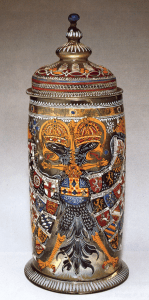Enamel Glass: Imperial Eagle Tankard - German/German

This large tankard is called the Imperial Eagle Tankard. It is 31 centimetres high and has a capacity of almost 4 litres. From the 16th to the 18th century, it was one of the most popular drinking vessels. Secular and clerical dignitaries such as emperors, electors and popes used the huge glass body to explain the structure of the empire to the people in a pictorial form.
In doing so, they made use of the double-headed imperial eagle, also known as the quaternion eagle. This is because those imperial estates whose members had a common characteristic were grouped together in fictitious groups of four, the quaternions. There was the group of electors, margraves and so on. In the wings of the eagle you can see 56 coats of arms. They stand for the individual groups of the imperial constitution. At the very top, near the eagle's head, you can see the coats of arms of the electors and popes.
Owners of imperial eagle tankards were mostly members of the smaller imperial estates such as patricians, the guild bourgeoisie and craftsmen. It was particularly important to them to express their attachment to the empire and its members. And how could they do this better than by passing around an imperial eagle hump when drinking socially?
The imperial eagle tankards were also valued for their decorative effect and the bright enamel colours. In this technique, finely ground glass is fired onto the finished glass at 800 degrees Celsius. Syrian glass painters in antiquity already took advantage of this. In the 16th century, enamel painting reached Germany via Venice and remained here until the 18th century.
Enamelled Glass: Imperial Eagle Tankards - English

This large tankard is called an imperial eagle tankard. It is 31 cm tall and can hold almost 4 L of liquid. From the 16th to the 18th century it was one of the most popular drinking vessels. Secular and spiritual dignitaries such as emperors, electoral princes and popes used these enormous glass containers to tell the story of the development of the Empire in pictorial form.
In doing this they made use of the double-headed imperial eagle, which is also known as the quaternion eagle, because imperial states with a common attribute were grouped together into fictitious groups of four: Quaternions. There was the group of electoral princes, the margraves and so on. In the Eagle's pinions you'll be able to see the 56 coats of arms. These stand for the individual groups of the imperial constitution. Right at the top near the eagle's head are the electoral princes' and the popes' coats of arms.
Owners of imperial eagle tankards were predominantly members of the smaller estates of the Empire such as patricians, guild members and craftsmen to whom the outwardly expression of their connections to the Empire and its links, was extremely important. And what better way to do this than passing round an imperial eagle tankard during a social glass-raising?
The imperial eagle tankards were also valued for their decorative effect and their vibrant enamel colours. The enamelling technique involves burning finely ground glass onto the finished glass at 800°C. It was a technique already used by Syrian glass painters during antiquity. Enamelling came to Germany during the 16th century via Venice and remained popular until into the 18th-century.